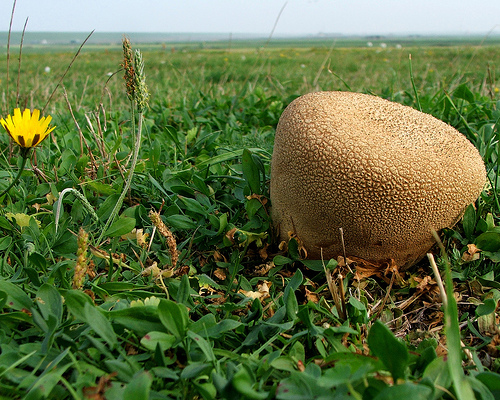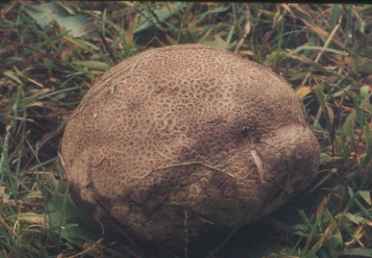Elite life

Mushrooms
Calvatia
║ Mushrooms ║
Giant Puffball (Calvatia gigantean, Langermannia gigantean)

Fruit body 7-80 cm across, subglobose, whitish and leathery, the outer wall breaking away to expose the spore mass, attached to the substrate by a root-like mycelial cord which breaks leaving the fruit body free to roll around and so scatter the millions of spores. Gleba olivaceous-brown and powdery at maturity; sterile base absent or rudimentary. Spores tawny brown, globose, finely warted, 3.5-5.5 μm in diameter.
Western Giant Puffball (Calvatia booniana)

Most giant puffballs grow to be 10 to 70 cm in diameter, although occasionally some can reach diameters up to 150 cm and weights of 20 kg. The inside of the mature Giant puffballs is greenish brown, whereas the interior of immature puffballs is white.
Puffball (Calvatia bovista)

Sporocarp: Fruiting body 7.0-25.0 cm broad, 9.0-20.0 cm tall, turbinate to compressed-pyriform; apex of fruiting body rounded or dimpled when young, becoming flattened to depressed, tapering gradually or abruptly to a well developed sterile base; exoperidium approximately 1.0-1.5 mm thick, white to cream-colored, dull brown in age, tomentose to subfloccose, fibrils often forming stellate scales, these in turn aggregated into larger areolate patches, especially on the upper portions of the of the immature fruiting body; endoperidium thin, membranous, disintegrating apically, producing a crater-like opening; gleba cream-colored, soft, soon yellowish-green to olive-brown, powdery in age; subgleba occupying the lower third to one-half of the fruiting body, separated from the gleba by a membranous diaphragm, subglebal tissue composed of cream-colored cells up to 1 mm in diameter; odor and taste of immature gleba not distinctive.
Spores globose to subglobose, 4.5-5.5 μm in diameter, smooth, moderately thick-walled, with a single oil droplet, lacking a pedicel; spores olive-brown in mass; capillitial pits common, consisting mostly of sinuous slits.
Purple-Spored Puffball (Calvatia cyathiformis)

Fruiting body: 5-20 cm high and/or broad; round or flattened when young; becoming pear-shaped or round with a flattened top and narrowed base; white, tan or pinkish gray to light brown; smooth, the skin cracking and flaking with age; sterile base prominent, chambered, white to dingy yellow or darker, persisting as a deep purplish to purple-brown cuplike structure after the spores have dispersed; flesh white and firm when young, becoming yellowish, then brownish and finally dull purple and powdery. Spores 3.5-7.5 μm; round, spiny or warty to nearly smooth. Capillitial threads 3-7.5 μm wide; thick-walled; minutely pitted.
║ Mushrooms ║